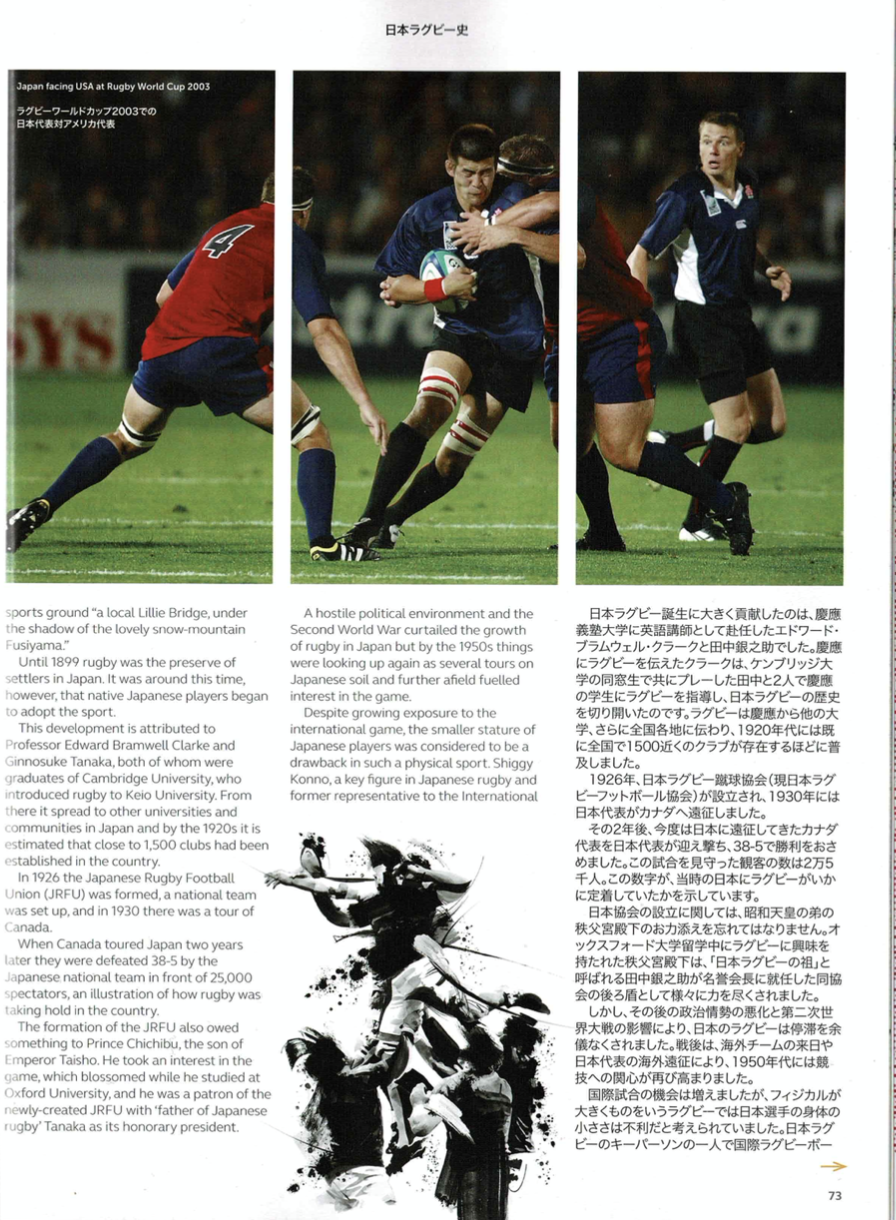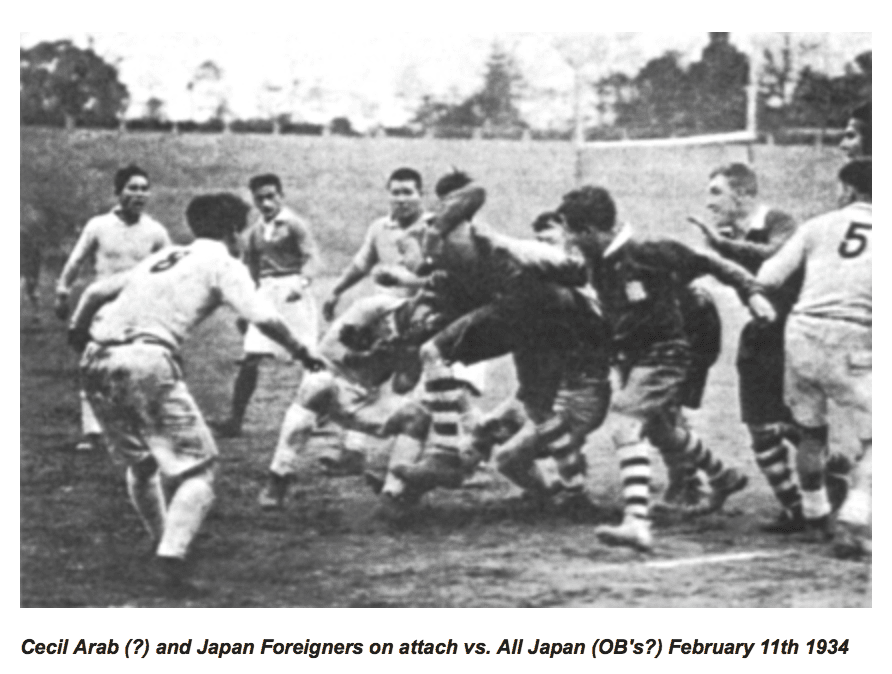The content of the article ‘Brief history of rugby in Japan’ which is around 850 words long in the 114 –page RWC 2019 publication being sold at the early RWC games could be judged by some as an insult to Japan’s present and past rugby players and teams. The layout of the Japanese text in general seems somewhat disrespectful to the Japanese language and to the Japanese people who are supposed to be hosting this World Cup. If World Rugby actually wanted Japanese people to buy, read and treasure the program, they should have consulted with experts about providing accurate and higher-quality contents and lay out the Japanese text in a more Japanese style.

Looking at the content of the article, the third line referring to rugby in Japan ‘dating back to the 1860s’ is followed by the statement ‘That makes Japan the first country outside the British Isles and Australia to take up the sport.’ Japan as a country didn’t ‘take up’ rugby in the 1860s. Rather, there is evidence that a small number of non-Japanese were playing an early form of ‘Rugby School rules’ football then. At the same time, early forms of rugby were also being played in New Zealand, South Africa, Canada and the USA. One important fact that is omitted is that the YFBC is currently recognized by the World Rugby Museum at Twickenham as the first ‘rugby’ club established in Asia.
Roughly the first third of the article is a somewhat misleading version of my research into the football played in the 1860s. For example, the writer says that ‘the concept of rugby’ was introduced to Japan by ‘British soldiers’ but the first recorded playing of an early form of rugby in Japan took place in 1863, nearly a year BEFORE the first British soldiers arrived in Yokohama. Those playing in 1863 were naval officers and civilians. The article states that the battalion ‘included men who had been educated at rugby-playing schools’ but in the 1850s and early 1860s there weren’t really any ‘rugby-playing schools’ apart from Rugby School itself. The RFU was only founded in 1871. At that time British military units were made up of ‘officers’ and ‘men’ and it was the officers who attended football-playing private schools – not the men. It would also be helpful to readers if there was a little background or explanation as to why and how the British troops came to be in the land of the shogun.
The writer clearly doesn’t know very much about the rugby history of Japanese first teams either. Stating that there were 1,500 clubs ‘by the 1920s’ is complete nonsense although I know where that information came from. It comes from Richard Bath who in his book The Ultimate Encyclopedia of Rugby (London: Carlton Books Limited,1997) p. 70 :wrote “Although rugby was first played in Japan in Yokohama in the early 1870s between British sailors, the game only took hold when introduced to Japan in 1897 by two students who had been studying in London. After that, rugby swept through the Universities, which remain the heartland of rugby in Japan, and by the 1920s, there were nearly 1,500 clubs in Japan and in excess of 60,000 players.” Until a few years ago Richard Bath’s quote that rugby caught on ‘with alacrity’ in Japan after first being introduced in 1899 stood out in the Wikipedia URL on the history of Japanese rugby as a classic indication of his ignorance because after Keio University started playing rugby in 1899, it was eleven years before the next rugby team was formed.
At the beginning of 1920 it is possible that there were less than five teams or clubs in the Tokyo area (the two main ones were Keio and Waseda universities) and maybe only around 10 nationwide. Even at the very end of the 1920s there were only about 150 teams or clubs.
The only Japan-based clubs mentioned in the story are the Yokohama Foot Ball Club, whose name appears a ridiculous FOUR TIMES, and Keio University with one mention. There is no mention at all of the other great teams of Waseda, Tokyo and Meiji Universities or of the corporate teams like Yawata Steel, Nippon Steel, etc.

The most shameful thing about the story and perhaps the worst insult of all to the world of rugby in Japan is that, in a publication that focuses mainly on great photographs, there are no photos at all of the illustrious performances by Japanese players in the 20th century, or even team photos. There is but one small miserable poor-quality photograph with no caption that apparently relates to the story but in fact has almost no connection. I know this photo well because I am the original source of it. It was directly or indirectly taken from this URL: http://ycacrugby.com/about/ (it is also here: https://galbraith.press/glimpses-of-ycac-and-rugby-in-japan-on-and-off-the-field-in-1920s-1930s-bill-salters-reminiscences/) – an article that I wrote about thirty years ago about the reminiscences of one of two YC&AC members who had played in the 1920s and 1930s. I visited the JRFU offices in 1989 and asked if they had any photos of foreigners playing in that period that I could use in an article in a YC&AC overseas tour program.

I selected that photo because it showed YC&AC member Cecil Arab (dark shirt) playing for a Japan Foreigners team against All Japan (probably OBs) on February 11 1934. Is it really a suitable in any way to be the sole rugby history photo for the 2019 RWC program? No! It isn’t. Why did the editor not use the famous 1901 photo of the Keio team or one of the many great photos of early Japanese rugby? Those that know Japan’s rugby history know that there are many great photos. Despite probably receiving many millions of dollars from those who took out very expensive ads in the program in the expectation that this would be a top of the line publication, the use of this photo appears to demonstrate clearly just how much effort the editor and the writer of this story put into it. Frankly, it is disgarce
The article fails to provide any information about Japan’s unique rugby culture and ignores the first glorious period of the1930s when the country produced players like KASAHARA Tsuneo who were judged by their opponents to be world-class.
Not only does the RWC publication fail to give fans a satisfactory amount of information about the history of rugby of the host country but it also fails to provide any information at all on the rugby history of the other participating countries.
I assume that before the semis and finally the final, the producers of the publication will have to reprint the basic contents and I urge them firstly to at least correct their errors and secondly to include more genuine historic photographs of Japanese rugby.
